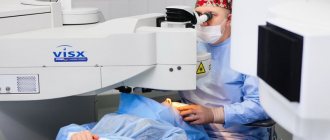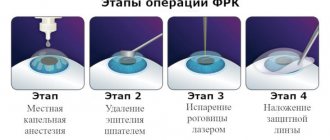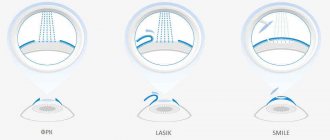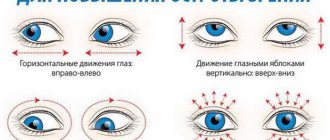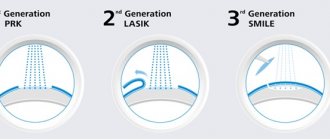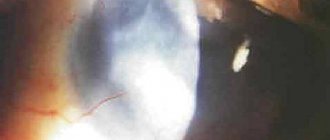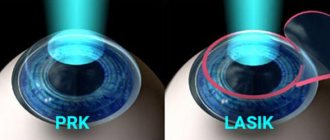Features of laser surgery for astigmatism
Astigmatism implies the absence of a focal point. It occurs due to the irregular shape of the cornea, less often the disease is caused by a change in the shape of the lens.
The peculiarity of laser vision correction is the formation of a spherical surface. Achieving a normal shape of the cornea is achieved by removing its superficial and deeper layers.
Vision correction for astigmatism and myopia is carried out by burning a precisely calculated amount of tissue to give the required shape.
Indications for laser vision correction for astigmatism
Glasses and contact lenses are suitable treatments for astigmatism, but for permanent and complete recovery, laser eye surgery is the primary option. Modern methods of laser surgery make it possible to treat even the most severe astigmatists with great success.
Whether surgery is appropriate will depend on your overall health and other factors.
Laser correction is indicated in the following cases:
- astigmatism is combined with myopia;
- presence of the disease at the age of over 18 years;
- refractive error greater than 3 diopters;
- the presence of progressive pathologies of the inflammatory nature of oncology.
Summary
Astigmatism is a refractive error in which the eye focuses light unevenly on the retina. This results in distorted or blurred vision. The disease also manifests itself as constant eye strain and headaches. The choice of laser vision correction technique largely depends on the severity of the pathology, as well as the individual characteristics of the patient’s visual system. Most often, patients use LASIK, LASEK or Relex Smile. The cost of refractive laser surgery for astigmatism is determined taking into account the type of disease, correction method, level of the clinic and the qualifications of the doctor. The starting price is $990. To treat this pathology, foreign patients choose specialized centers: Batygoz, Hangil, Dunyagoz and Spreebogen.
APPOINTMENT FOR ASTIGMATISM TREATMENT
We will help organize laser correction of astigmatism abroad. Our coordinators will be constantly in touch with the patient at all stages of the medical trip.
Contraindications
Laser treatment of astigmatism is contraindicated in patients over 45 years of age, with progressive forms of refractive error (myopia or hypermetropia), glaucoma and lens opacification.
Laser correction is not performed for acute inflammatory processes and infectious diseases. It is also contraindicated during pregnancy, the postpartum period, during breastfeeding (since it will require taking antibiotics and other drugs that pass into breast milk) and for endocrine disorders.
Types of laser vision correction
Correction is possible using all currently existing methods:
- ReLex SMILE - this vision correction is indicated for astigmatism and myopia or a combination of both refractive errors with a small incision on the surface of the cornea.
- FLEX is 100% femtosecond technology. Similar to SMILE, an individual lens is cut into the cornea, but a flap cap is cut around its circumference to remove it.
- Femto LASIK—use of a femtosecond laser.
- LASIK—Laser keratomileusis is used to treat nearsightedness, farsightedness, and astigmatism. Since its invention in the early 90s, LASIK has been the most popular surgical treatment for correcting refractive errors. Treats vision defects by reshaping the cornea to correct the way light is focused at the back of the eye.
- PRK involves creating a thin circular flap and loosening the top layer of corneal cells using a special solution. This surgery may be an option for patients who are looking for a cost-effective refractive laser surgery option.
- Opti LASEK is a more advanced OptiPRK technique. It consists of removing the epithelium in a single layer, returning to the surface at the end and installing a contact lens.
What kind of disease is this?
Astigmatism is one of the most common causes of visual impairment and is a violation of the natural shape of the lens, which is combined with uneven curvature of the cornea. Such a defect results in a person losing the ability to clearly see objects.
The human eye is a kind of complex system of lenses through which light rays pass, focusing on a specific point on the retina. Thus, a person receives a clear image of objects, which is absent with astigmatism. The cornea of a healthy person has a spherical shape and thanks to this it collects light rays from one point.
The eyes of people suffering from astigmatism have an elongated cornea, which refracts rays passing through different points differently. This defect is the reason that light rays cannot be concentrated at one point on the retina, and therefore the image that a person sees is blurry and unclear.
Unlike myopia and farsightedness, the formation of astigmatism is not affected by prolonged use of the computer and other gadgets. As a rule, astigmatism is a hereditary eye disease in humans. Ophthalmologists recommend paying special attention to the vision of a child whose family members suffer from this visual defect.
How to correct the optics of an eye with incorrect focusing? First of all, you need to understand that an accurate diagnosis can only be made by a qualified ophthalmologist. The specialist will advise what studies need to be carried out to clarify the state of the visual system. Only based on the totality of all data can you choose the optimal method of combating astigmatism.
It is important to consider the following factors:
- The part of the eye that needs correction.
- Dynamics of disease development.
- Patient's age.
Today, there are three ways to correct astigmatism - wearing glasses, using contact lenses and laser vision correction.
1. Correct selection of glasses is possible if the disease is detected at an early stage. The choice of glasses must be entrusted to a professional ophthalmologist; self-medication in this case can have catastrophic consequences for vision. Diagnosis of astigmatism is carried out sequentially in each eye of the patient using various methods.
In cases with simple focusing problems, the situation will be corrected by glasses with spherical lenses, which refract rays only along the axis where there is astigmatism. In more complex cases, only spherocylindrical lenses can solve the problem. Often, in patients suffering from astigmatism, in addition to this disease, farsightedness and myopia are also diagnosed. The specialist’s task is to choose glasses that will help cope with all diseases.
The process of adapting a patient with astigmatism to glasses is quite complex. Therefore, ophthalmologists first select a weaker option, and only as the person gets used to it, after a few months, do they prescribe stronger lenses.
Particular attention should be paid to those patients who have never worn glasses before. The recommendation also applies to elderly patients, whose adaptation process is also often complicated by poor health: dizziness, headaches.
Laser correction for astigmatism
The use of laser correction for refractive error depends on the type of procedure prescribed.
Some choose PRK despite the longer recovery period and discomfort after surgery. The outer top layer of cells is removed to expose the second layer to the laser. A protective bandage is put on the eye until the epithelium is restored.
The smile is made using a short impulse. The device is programmed to pass harmlessly through the top layers of the cornea, focusing on a specific sublayer to create a lenticule. The outer layer is not removed; only a small cut is made on the surface.
On average, the procedure takes 23 seconds for one organ of vision. The surgeon removes the lens formed by the laser inside the cornea. The corneal nerves that stimulate the tear glands are less affected and can therefore still help keep the eye moist.
With LASIK, the surgeon creates a piece of tissue by making a flap at the front of the eye to expose the inner layers of tissue to the laser. They use either a mechanical instrument called a microkeratome or a femtosecond laser. The excimer laser shapes the cornea by removing tissue that has been exposed to it. The procedure is completed by returning the flap to its original position.
After operation
Vision recovery occurs quickly. Upon arrival home, the patient will see better. Visual perception is completely normalized over the next 24 hours.
After operation:
- Do not rub the operated eye;
- rest more and not overexert yourself;
- wear sunglasses to prevent sun exposure and harmful UV rays;
- use eye drops for several days after surgery to prevent infection and relieve dryness;
- Avoid contact sports for 2 weeks.
Doctors recommend wearing the patch for 1 week while you sleep to avoid accidentally scratching your eye while it heals.
Smile is a minimally invasive procedure, which means there is usually minimal discomfort during the healing period. In most cases, vision stabilizes within a week after surgery.
The eye may sometimes feel uncomfortable. It usually takes 4-5 days to grow a new layer of cells. After this, the doctor will remove the bandage.
Price
Table. The cost of laser vision correction for astigmatism, depending on the type
| Type of operation | Average price in rubles | |
| Lasik | with simple astigmatism up to -1 diopter | 7681 |
| up to -4 diopters | up to 18000 | |
| ReLex SMILE | 70000 | |
| Femto LASIK | 20000 | |
| PRK | 11400 | |
What is astigmatism?
Astigmatism
is a common eye disease characterized by blurred vision. This pathology is caused by an irregularly shaped cornea or lens. Symptoms of the disease include distorted vision, headaches and constant eye strain. Astigmatism is often combined with farsightedness (hyperopia) or nearsightedness (myopia). Without timely treatment, it progresses over time and can cause vision loss. There are five main forms of the disease:
- simple myopic astigmatism
, where light hits one focal point in front of the retina and another on the retina;
simple farsighted astigmatism
, when light hits one focal point on the retina and another behind it;
compound myopic astigmatism
, where light hits two focal points, both in front of the retina, but in two different places;
- compound hyperopic astigmatism
, where light hits focal points that are both behind the retina in different places;
mixed astigmatism
, when light rays hit two focal points, one of which is in front of the retina and the other behind the retina.
CONTACT MEDIGLOBUS SPECIALISTS
MediGlobus coordinating doctors will answer all questions regarding the treatment of astigmatism abroad. We will help you choose a medical center and doctor, and also advise you on the cost of laser correction. Click on the button, leave a request and wait for a response within 30 minutes.
Patient reviews
Valentina: I can’t say that the operation helped me restore my vision 100%. After laser correction, you still have to wear glasses if you need to see the bus number in advance. I use it when reading and watching TV. Otherwise the picture is clear, but not 100%.
Sergey: It took me a long time to decide on laser correction. On the day of the operation everything went quickly. The next day the doctor examined me. I noticed minor hemorrhages, but within 5 days everything went away. Now more than 2 years have passed, I have 1 in both eyes. I undergo annual examinations and am glad that my eyes can see again.
LASIK for astigmatism correction
The LASIK technique is considered universal for the correction of all refractive errors, and combines the precision of an excimer laser and the intelligence of microsurgical instruments in the experienced hands of a surgeon. One of the main advantages of this technique is its high efficiency. It is also very important that during the operation the layer-by-layer anatomy of the cornea is completely preserved. After laser correction using LASIK, there is a high probability that the patient will no longer need glasses or contact lenses. After all, most often vision after surgery is restored to normal levels. The postoperative period of LASIK involves a minimum of restrictions for the patient. Already on the day of the operation, some time after the intervention, he goes home and can read, watch TV, work, etc.
Another type of LASIK, FemtoLASIK is a modified version of the traditional technology. Its difference is that the superficial flap, formed to access the corneal stroma, on which the correction is carried out, is performed not with a mechanical keratome, but with a femtosecond laser. This reduces the procedure time and allows manipulations to be performed with greater precision.
The prefix “super” is often added to the abbreviations LASIK and FemtoLASIK. However, this does not mean that such methods are better than others. It’s just that the on-board computer program of the laser system (excimer or femtosecond) contains complete data on the parameters of the patient’s cornea, which makes the operation strictly personalized. In most cases, such personification is not required, but if there are some individual structural features of the patient’s ocular media and orbit that can affect the outcome of the operation, detailed cartographic data cannot be avoided. It is worth knowing that surgery with the prefix “super” costs several orders of magnitude more than regular LASIK.

